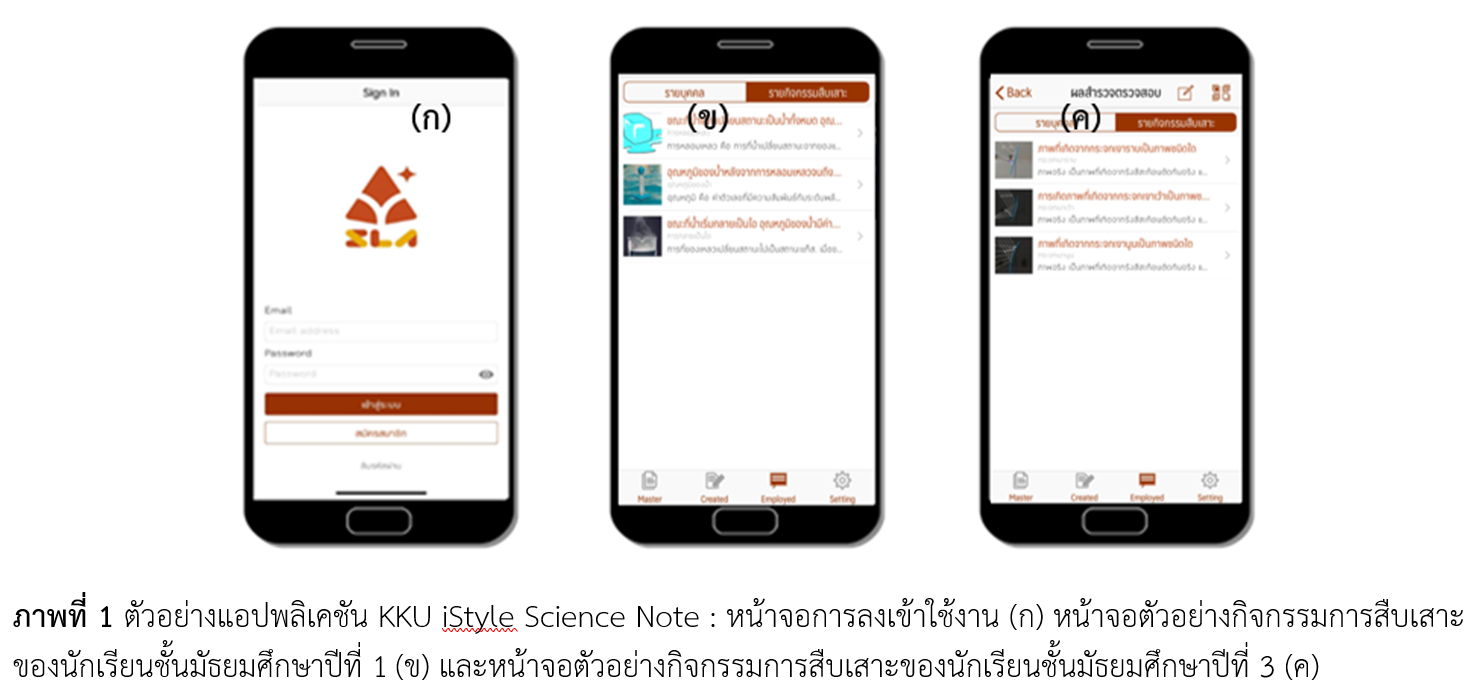ผลของการเสริมสร้างแรงจูงใจทางวิทยาศาสตร์ของนักเรียนระดับมัธยมศึกษาตอนต้นในบริบทชุมชนชนบทโดยใช้กลวิธีการเรียนรู้วิทยาศาสตร์สืบเสาะแบบไร้รอยต่อ
Main Article Content
บทคัดย่อ
แรงจูงใจทางวิทยาศาสตร์เป็นปัจจัยสำคัญที่มีอิทธิพลต่อประสิทธิภาพของการเรียนรู้ของผู้เรียนยุคใหม่ การเรียนรู้แบบไร้รอยต่อเป็นกลวิธีการเรียนรู้ที่เชื่อมต่อช่องว่างการเรียนรู้ให้มีความหมายและประสิทธิภาพมากยิ่งขึ้น ซึ่งการเรียนรู้เช่นนี้นั้นเป็นการนำเทคโนโลยีดิจิทัลเข้ามามีบทบาทในการจัดการเรียนรู้และเป็นตัวช่วยในการส่งเสริมการเรียนรู้ของนักเรียน งานวิจัยนี้มีวัตถุประสงค์เพื่อศึกษาแรงจูงใจทางวิทยาศาสตร์ของกลุ่มนักเรียนที่ได้รับการจัดการเรียนรู้ด้วยกลวิธีการเรียนรู้วิทยาศาสตร์สืบเสาะแบบไร้รอยต่อผ่านการประยุกต์ใช้เทคโนโลยีสมาร์ตโฟนสำหรับนักเรียนชั้นมัธยมศึกษาตอนต้น จำนวน 45 คน โดยเป็นนักเรียนชั้นมัธยมศึกษาปีที่ 1 และปีที่ 3 ของโรงเรียนภาครัฐแห่งหนึ่ง นักเรียนได้รับการจัดการเรียนรู้ด้วยกลวิธีการเรียนรู้วิทยาศาสตร์สืบเสาะแบบไร้รอยต่อเป็นระยะ 300 นาที และเก็บรวบรวมข้อมูลแรงจูงใจทางวิทยาศาสตร์โดยใช้แบบสอบถามแบบประมาณค่า 5 ระดับ จำนวน 25 ประเด็น ซึ่งแบ่งออกเป็น 5 ด้านย่อย ได้แก่ ความจูงใจภายใน (IM) ความจูงใจในอาชีพ (CM) การตัดสินใจด้วยตนเอง (SDT) ประสิทธิภาพของตนเอง (SEC) และ ความจูงใจในผลการเรียน (GM) โดยที่นักเรียนถูกประเมินแรงจูงใจทางวิทยาศาสตร์ทั้งก่อนเรียนและหลังเรียนกับกลวิธีดังกล่าว ผู้วิจัยวิเคราะห์ข้อมูลเพื่อเปรียบเทียบแรงจูงใจทางวิทยาศาสตร์ของนักเรียนโดยใช้การวิเคราะห์สถิติทดสอบทีสำหรับกลุ่มอิสระ (Independent Samples t-test) ผลการวิจัยพบว่า มิติย่อยด้าน IM, CM, SDT, และ SEC ของแรงจูงใจทางวิทยาศาสตร์มีคะแนนเฉลี่ยหลังเรียนสูงกว่าก่อนเรียน ยกเว้นด้าน GM เท่านั้นที่มีผลตรงกันข้าม และพบว่านักเรียนกลุ่มนี้มีการพัฒนาด้าน IM และ CM อย่างมีนัยสำคัญทางสถิติ การศึกษานี้ได้แสดงให้เห็นอย่างชัดเจนว่า การใช้วิธีการเรียนรู้ที่สืบเสาะแบบไร้รอยต่อโดยใช้เทคโนโลยีสมาร์ตโฟนช่วยเสริมสร้างแรงจูงใจทางวิทยาศาสตร์ในมิติที่เฉพาะเจาะจงสำหรับนักเรียนชั้นมัธยมศึกษาตอนต้นอย่างมีนัยสำคัญ
Article Details

อนุญาตภายใต้เงื่อนไข Creative Commons Attribution-NonCommercial-NoDerivatives 4.0 International License.
วารสารวิทยาศาสตร์และวิทยาศาสตร์ศึกษา (JSSE) เป็นผู้ถือลิสิทธิ์บทความทุกบทความที่เผยแพร่ใน JSSE นี้ ทั้งนี้ ผู้เขียนจะต้องส่งแบบโอนลิขสิทธิ์บทความฉบับที่มีรายมือชื่อของผู้เขียนหลักหรือผู้ที่ได้รับมอบอำนาจแทนผู้เขียนทุกนให้กับ JSSE ก่อนที่บทความจะมีการเผยแพร่ผ่านเว็บไซต์ของวารสาร
แบบโอนลิขสิทธิ์บทความ (Copyright Transfer Form)
ทางวารสาร JSSE ได้กำหนดให้มีการกรอกแบบโอนลิขสิทธิ์บทความให้ครบถ้วนและส่งมายังกองบรรณาธิการในข้อมูลเสริม (supplementary data) พร้อมกับนิพนธ์ต้นฉบับ (manuscript) ที่ส่งมาขอรับการตีพิมพ์ ทั้งนี้ ผู้เขียนหลัก (corresponding authors) หรือผู้รับมอบอำนาจ (ในฐานะตัวแทนของผู้เขียนทุกคน) สามารถดำเนินการโอนลิขสิทธิ์บทความแทนผู้เขียนทั้งหมดได้ ซึ่งสามารถอัพโหลดไฟล์บทความต้นฉบับ (Manuscript) และไฟล์แบบโอนลิขสิทธิ์บทความ (Copyright Transfer Form) ในเมนู “Upload Submission” ดังนี้
1. อัพโหลดไฟล์บทความต้นฉบับ (Manuscript) ในเมนูย่อย Article Component > Article Text
2. อัพโหลดไฟล์แบบโอนลิขสิทธิ์บทความ (Copyright Transfer Form) ในเมนูย่อย Article Component > Other
ดาวน์โหลด ไฟล์แบบโอนลิขสิทธิ์บทความ (Copyright Transfer Form)
เอกสารอ้างอิง
Anderman, E. M. and Midgley, C. (1997). Changes in achievement goal orientations, perceived academic competence, and grades across the transition to middle-level schools. Contemporary Educational Psychology, 22(3), 269–298.
Apereo Foundation. (2017). Apereo Learning Analytics Initiative. Retrieved 1 September 2020, from Apereo: https://www.apereo.org/projects/openlrs
Ardura. D and Pérez-Bitrián. A. (2018). The effect of motivation on the choice of chemistry in secondary schools: adaptation and validation of the Science Motivation Questionnaire II to Spanish students. Chemistry Education Research and Practice, 19(3), 905-918.
Barak, M. (2014). Closing the Gap Between Attitudes and Perceptions About ICT-Enhanced Learning Among Pre-service STEM Teachers. Journal of Science Education and Technology, 23(1), 1–14.
Buck L. B., Bretz, S. L. and Towns, M. H. (2008). Characterizing the Level of Inquiry in the Undergraduate Laboratory. Journal of College Science Teaching, 38(1), 52-58.
Chan, T. W., Roschelle, J., Hsi, S., Kinshuk, Sharples, M., Brown, T., Patton, C., Cherniavsky, J., Pea, R., Norris, C., Soloway, E., Balacheff, N., Scardamalia, M., Dillenbourg, P., Looi, C.-K., Milrad, M. and Hoppe, U. (2006). One-to-one technology-enhanced learning: an opportunity for global research collaboration. Research and Practice in Technology-Enhanced Learning, 1(1), 3–29.
Crawford, B. A. (2014). From inquiry to scientific practices in the science classroom. In N. G. Lederman & S. K. Abell (Eds.), Handbook of Research on Science Education (pp. 515–541). Routledge.
Fortus, D., and Touitou, I. (2021). Changes to students’ motivation to learn science. Disciplinary and Interdisciplinary Science Education Research, 3(1), 1-14.
Glynn, S. M., Brickman, P., Armstrong, N. and Taasoobshirazi, G. (2011). Science motivation questionnaire II: Validation with science majors and nonscience majors. Journal of Research in Science Teaching, 48(10), 1159-1176.
Kohen, Z. (2019). Informed integration of IWB technology, incorporated with exposure to varied mathematics problem-solving skills: Its effect on students’ real-time emotions. International Journal of Mathematical Education in Science and Technology, 50(8), 1128–1151.
Lamb, R., Akmal, T. and Petrie, K. (2015). Development of a cognition-priming model describing learning in a STEM classroom. Journal of Research in Science Teaching, 52(3), 410–437.
Looi, C. K., Seow, P., Zhang, B., So, H.-J., Chen, W. and Wong, L.-H. (2010). Leveraging mobile technology for sustainable seamless learning: a research agenda. British journal of educational technology, 41(2), 154–169.
Rennie, L. J., Goodrum, D. and Hacking, M. (2001). Science teaching and learning in Australian schools: Results of a national study. Research in Science Education, 31(4), 455–498.
Schunk, D. H., Pintrich, P. R. and Meece, J. L. (2008). Motivation in education: Theory, research, and application. Upper Saddle River: Pearson.
Sharples, M., Scanlon, E., Ainsworth, S., Anastopoulou, S., Collins, T., Crook, C. and Malley, C. O. (2015). Personal inquiry: Orchestrating science investigations within and beyond the classroom. The Journal of the Learning Sciences, 24(2), 308–341.
Soodjai, S. and Srisawasdi, N. (2021). Effect of Digital Card Game-based Open Inquiry Science Learning on Protein Synthesis on Secondary School Students’ Learning Motivation toward Biology (in Thai). Journal of Education Khon Kaen University, 44(4), 68-83.
Sritawan, N. and Srisawasdi, N. (2022). Effect of seamless STEM learning on Newton’s law of motion on scientific explanation competency (in Thai). Journal of Education (Graduate Studies Research) Khon Kaen University, 16(1), (32-54).
University of Colorado Boulder. PhET: Geometric Optics. Retrieved 13 October 2020, from PhET Interactive Simulations: https://phet.colorado.edu/th/simulations/geometric-optics
Vedder-Weiss, D. and Fortus, D. (2012). Students’ declining motivation to learn science: A follow-up study. Journal of Research in Science Teaching, 49(9), 1057–1095.
Wong, L. H. and Looi, C. K. (2011). What seams do we remove in mobile-assisted seamless learning? A critical review of the literature. Computers & Education, 57(4), 2364 - 2381.
Yodsanga, S. and Srisawasd, N. (2021) The Effect of Using Digital Board Game-Based Learning Scientific Inquiry Approach. On Science Motivation Regarding Photosynthesis Phenomenon (in Thai). Journal of Education Khon Kaen University, 44(3), 144-162.


